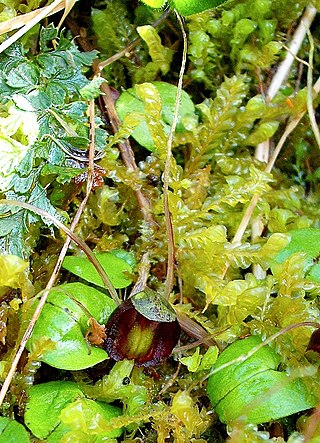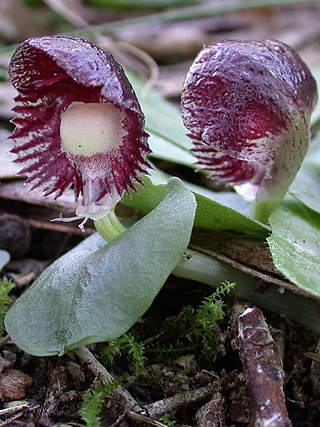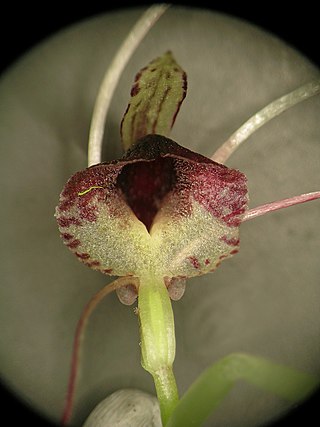
Macquarie Island is an island in the southwestern Pacific Ocean, about halfway between New Zealand and Antarctica. Regionally part of Oceania and politically a part of Tasmania, Australia, since 1900, it became a Tasmanian State Reserve in 1978 and was inscribed as a UNESCO World Heritage Site in 1997.

Corybas, commonly known as helmet orchids, is a genus of about 120 species of plants in the orchid family, Orchidaceae. Helmet orchids are small, perennial, deciduous herbs and are nearly always terrestrial. They have a single leaf at their base and a single flower on a short stalk, the flower dominated by its large dorsal sepal and labellum. Species of Corybas are found in Australia, New Zealand, New Guinea, Southeast Asia, the Himalayas, southern China, many Pacific islands and a few sub-Antarctic islands.
Corybas sulcatus, also known as the grooved helmet-orchid, is one of two helmet orchids endemic to Australia’s subantarctic Macquarie Island, and the second to be discovered. The Latin specific epithet sulcatus means "grooved”, with reference to the prominent groove in the labellum boss. It is a small, terrestrial, tuberous, herbaceous plant that forms clonal colonies. The flower is erect, mostly dark red, 25–30 mm long and 10–14 mm wide. The flowering period is November–December. It occurs on the plateau uplands of the island, growing in wet grassy seepage areas. It can be distinguished from the only other orchid on the island, Corybas dienemus, by its dark red flowers.

Corybas aconitiflorus, commonly known as the cradle orchid or spurred helmet orchid, is a species of terrestrial orchid endemic to eastern Australia, occurring from south-east Queensland to Tasmania. The small flowers have a hooded appearance as the uppermost sepal hides most of the rest of the flower. It is the type species of the genus Corybas.

Corybas hispidus, commonly known as the bristly helmet orchid, is a species of orchid endemic to eastern Australia. It is distinguished from other helmet orchids by its autumn to winter flowering period, and by its labellum, which has a bristly-hairy, creamy-white centre and is deeply notched along its top edge.
Prasophyllum milfordense is a species of orchid endemic to Tasmania. It has a single tubular, dark green leaf and up to thirty greenish-brown, white and purplish flowers. It is a very rare orchid, only found in a single location with a population of around 240 plants.
Genoplesium littorale, commonly known as the Tuncurry midge orchid, is a species of small terrestrial orchid endemic that is endemic to New South Wales. It has a single thin leaf fused to the flowering stem and up to thirty small green flowers with a purple-brown labellum. It is only known from fewer than two thousand plants in a small area on the New South Wales North Coast and is critically endangered.

Arthrochilus huntianus, commonly known as common elbow orchid, is a flowering plant in the orchid family (Orchidaceae) and is endemic to south-eastern Australia. It has no leaves but an insect-like flower which has its labellum dangling like a lure away from the rest of the flower. Because of its thin, wiry stem and small, dull-coloured flowers, this orchid is difficult to locate. Like others in the genus, the flowers are pollinated by a species of thynnid wasp. Some authorities use the name Thynninorchis huntiana for this orchid.

Corybas confusus, commonly known as the spider orchid is a species of terrestrial orchid endemic to New Zealand. It has a single heart-shaped leaf and a single dark green or light green flower with reddish maroon streaks and blotches and long, thread-like lateral sepals and petals. It grows in highland areas on both main islands.
Corybas dentatus, commonly known as the Lofty Ranges helmet orchid, is a species of terrestrial orchid endemic to South Australia. It has a more or less round leaf and a single purplish and green flower. It is only known from two locations and is listed as "vulnerable" under the Environment Protection and Biodiversity Conservation Act.

Corybas despectans, commonly known as the tiny helmet orchid or sandhill helmet orchid is a species of terrestrial orchid endemic to southern Australia. It has round or heart-shaped leaf and a tiny reddish purple flower. Unlike many others in the genus, the dorsal sepal does not cover the labellum. It is similar to C. incurvus but the flowers are smaller.

Corybas diemenicus, commonly known as the stately helmet orchid or veined helmet orchid, is a species of terrestrial orchid endemic to south-eastern Australia. It has round or heart-shaped leaf and a reddish purple flower with a central white patch.
Corybas expansus, commonly known as the flared helmet orchid or dune helmet orchid is a species of terrestrial orchid that is endemic to South Australia. It has a heart-shaped to more or less round leaf and a single purplish flower with greenish or transparent areas.
Corybas fordhamii, commonly known as the banded helmet orchid or swamp helmet orchid, is a species of terrestrial orchid endemic to south-eastern Australia. It has an egg-shaped to heart-shaped leaf and a reddish to reddish purple flower which leans forward. It is similar to C. unguiculatis which does not grow in swamps and has a different labellum.
Corybas montanus, commonly known as the montane helmet orchid, is a species of terrestrial orchid endemic to Queensland. It forms small colonies and has single heart-shaped to round leaf and a reddish, self-pollinating flower with a curved dorsal sepal. It is only known from the Mount Barney National Park in south-east Queensland.

Corybas recurvus, commonly known as the western helmet orchid or common helmet is a species of terrestrial orchid endemic to Western Australia. It has round or heart-shaped leaf and a dark reddish purple or purplish black flower. It is widespread and common between Bunbury and Albany.

Corybas undulatus, commonly known as tailed helmet orchid, is a species of terrestrial orchid endemic to eastern Australia. It has a single leaf and a single translucent grey flower with reddish markings, and a labellum with a bristly surface, fine teeth on the edge and a small tail on the tip.

Corybas hatchii is a species of terrestrial orchid endemic to New Zealand. It has a solitary rounded leaf, often flecked with maroon, and a single pale green and maroon flower with long, threadlike lateral sepals and petals.

Corybas iridescens is a species of terrestrial orchid endemic to the New Zealand. It has a solitary fleshy oval-shaped leaf and a single deep crimson flower, sometimes accompanied with green, with a tapering dorsal sepal.

Corybas papillosus is a species of terrestrial orchid endemic to the New Zealand. It has a solitary rounded leaf with a heart-shaped base and a single flower with a long, slender green dorsal sepal, as well as a crimson and white labellum.













